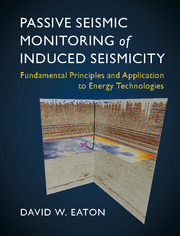 Passive Seismic Monitoring of Induced Seismicity
Passive Seismic Monitoring of Induced Seismicity Appendix A - Glossary
Published online by Cambridge University Press: 07 June 2018
Summary
Passive seismic monitoring of induced seismicity is a highly interdisciplinary field, combining aspects of seismology, continuum mechanics, fracture mechanics, geomechanics, structural geology, reservoir engineering and many other disciplines. Consequently, unfamiliar terminology can be a significant barrier to understanding. This glossary provides a concise explanation for some of the terms used in this book.
Acoustic medium: A medium in which shear waves are not considered or do not propagate, such as liquids or gases (Sheriff, 1991). Imaging methods used in exploration seismology commonly invoke an acoustic approximation and thus consider only P -wave propagation.
Aftershock: Earthquakes that follow the largest shock of an earthquake sequence. They are smaller than the mainshock and located within 1–2 rupture lengths distance from the mainshock. Aftershocks can continue over a period of weeks, months or years. In general, the larger the mainshock, the larger and more numerous the aftershocks, and the longer they will continue (USGS, 2017).
Anisotropy: Variation of one or more physical properties of a homogeneous material with the direction of measurement (Winterstein, 1990). A common form is transverse isotropy (TI), which is characteristic of shale, thinly bedded media and media with a single set of cracks; TI media have an infinite-fold axis of rotation (symmetry axis) and an infinite set of twofold axes of rotation in the perpendicular plane. The symmetry axis may be vertical (VTI), horizontal (HTI) or tilted (TTI). Another common form is orthorhombic, which has three mutually perpendicular symmetry axes and can arise from two sets of cracks, or a single set of vertical cracks in a layered medium (Figure 1.7). TI media are described by five independent elastic parameters, while orthorhombic media require nine independent parameters.
Anomalous seismicity: Seismicity that would not normally occur when performing an operation such as hydraulic fracturing (CAPP, 2017).
Asperity: In a literal sense, asperity means “roughness” (IRIS, 2017). An area on a fault this is stuck or locked.
b value: The slope of the magnitude-frequency distribution for the Gutenberg–Richter relation, which describes the relative size distribution of earthquakes. Most earthquake fault systems have a b value close to unity, implying that for each unit increase in magnitude there are ten times fewer earthquakes.
- Type
- Chapter
- Information
- Passive Seismic Monitoring of Induced SeismicityFundamental Principles and Application to Energy Technologies, pp. 281 - 291Publisher: Cambridge University PressPrint publication year: 2018
